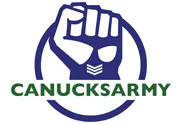On today’s episode of Canucks Conversation, David Quadrelli and Harman Dayal dove into the controversial statements made by Vancouver Canucks President of Hockey Operations, Jim Rutherford.
During a revealing interview with Gary Mason of The Globe and Mail, Rutherford addressed the long-standing alleged rift between Elias Pettersson and J.T. Miller. While both players have publicly refuted the rumours, Rutherford’s candid comments left little doubt that these issues are real, ongoing, and deeply embedded in the team’s dynamics.
What Rutherford’s Comments Mean for the Canucks
“What Rutherford said publicly today, everybody in the NHL and every team they’ve dealt with already knows,” said Quads.
Harm echoed that sentiment, adding, “I’m not entirely shocked he came out with a bombshell interview. Knowing his nature, he’s a remarkably straight-shooter and one of the most open-book GM/President of Hockey Ops we’ve seen this generation; he has that reputation going back to Pittsburgh even. The notion that this has backed the Canucks into a corner in terms of leverage; they were already backed into a corner. The whole hockey world knows about the issues Miller and Pettersson have had. I’ve been hesitant about how deep we talk about the rift and rumours because you don’t want to add fuel to the fire, but there’s a lot that’s already known, and word gets around. It’s important to clarify off the bat that the Canucks are negotiating from a position of weakness; there’s not a lot of plausible deniability to say, ‘We’re going to keep them both long term.’ Another important part is it doesn’t worsen the Canucks’ negotiating position because it’s already in a really tough spot.”
Transparency or Damage Control?
“This is what we’ve heard all season long; obviously, the Canucks’ preference is to keep these two players, but those comments from Jim Rutherford certainly sound like they’re past the point of being workable. It’s not a crazy take for him to have; it’s one we’ve had as well on the show for a while,” said Quads.
Harm questioned the rationale behind Rutherford’s public comments: “If it doesn’t damage their negotiating position, what does coming out and being this transparent actually accomplish? What’s the purpose? If management is at a point where they go out and move one of Miller or Pettersson, on paper, it’s going to be an L. It’s not going to be a stellar return. Even when you’re in a good negotiating position, when you’re trading players of their calibre away, and they’re the best player a part of the deal, you lose the deal. Rutherford acknowledged that when they shop those guys, it’s not a one-for-one deal. If part of it was to put the narrative out there and ready the fanbase for going down the road of trading these guys, and it’s an underwhelming return, at least the fanbase in advance has the context of the locker room chemistry issues and the idea that those two in the core as it’s currently constructed, can’t co-exist.”
Quads added, “We can put up with the idea that the media likes to stir things up, but this is the President of Hockey Operations, who has a better pulse on the room than any of us. He’s the one coming out and saying not only is it affecting the team, but it’s a problem and something they need to figure out.”
What Happens if the Canucks Move One of Them?
Harm emphasized the importance of how the Canucks use any potential cap space gained: “A key from Vancouver’s perspective is if you’re making a trade where you’re shipping out Miller or Pettersson, the key next step is going to be seeing how they deploy the cap space they potentially get. Maybe there’s a scenario where the package coming back, the salaries are roughly matching, and if that’s the case, the pieces you get back better be impact, part of your core, needle-mover type pieces. But if it’s a lesser return, some futures involved, it’s all about weaponizing cap space gained going into an offseason where the cap is going up, and you’ll have even more flexibility. If the Canucks go down this road of trading a core piece and wanting to maintain that competitiveness for Quinn Hughes; you’re not going to get the full picture on this until you see what the front office does with their assets and cap space in the summer.”
Rutherford himself seemed to acknowledge the reality of the situation: “We’ll have to do the best we can in trades. Whatever assets you get in return, you may turn them into something else. And we have to work our way back into being a contending team.”
The Locker Room Impact
The rift between Pettersson and Miller appears to be more than a minor dispute — it’s an underlying issue that is affecting both the locker room chemistry and the team’s performance. “When you don’t have chemistry, it’s hard to be that consistent team because there’s too much going on in the room for everybody to concentrate on what they’re supposed to do,” Rutherford admitted starkly.
The Canucks now face difficult decisions that could reshape the team for years to come. While fans may lament the potential loss of iconic players, as Harm suggested, much will depend on how the organization builds with newfound cap space, assets, and unity within the locker room.
You can watch the full segment below:
Sponsored by bet365

